 W
WCairo holds one of the greatest concentrations of historical monuments of Islamic architecture in the world, and includes mosques and Islamic religious complexes from diverse historical periods. Many buildings were primarily designated as madrasas, khanqahs or even mausoleums rather than mosques, but have nonetheless served as places of worship or prayer at some time or another, if not today.
 W
WSultan Abu al-'Ila Mosque is one of the most famous mosques in Islamic Cairo in Egypt. The mosque now base on 23 pure white marble columns. The platform is a masterpiece made of Indian teak. The roof is plated in gold leaf with amazing tiny trappings. Inside walls and dome are decorated with Islamic colored inscriptions. The dome at outside like all Mamluks's age is made of stone.
 W
WThe Al-Ashraf Mosque or Madrasa/Mosque of Sultan al-Ashraf Barsbay is a historical complex of mosque and madrasa located in Cairo, Egypt. The mosque was built during the Mamluk period by the Burji Sultan Al-Ashraf Al-Barsbay. The complex consists of a mosque-madrasa, mausoleum, and Sufi lodgings. The mosque is characterized by its design, which incorporates marble and stained-glass windows.
 W
WAl-Azhar Mosque, known simply in Egypt as al-Azhar, is an Egyptian mosque in Islamic Cairo. Al-Mu'izz li-Din Allah of the Fatimid dynasty commissioned its construction for the newly established capital city in 970. Its name is usually thought to derive from az-Zahrāʾ, a title given to Fatimah. It was the first mosque established in Cairo, a city that has since gained the nickname "the City of a Thousand Minarets".
 W
WAl-Fath Mosque is a mosque in the city of Cairo. Located in the Ramses Square, it is among the largest mosques and equips the tallest minaret in the city and the 3rd tallest in the world. During the post-coup unrest in Egypt, the Second Ramses Incident took place in the mosque on August 16, 2013 which resulted in the death and injury of several protesters and subsequent shut down of the mosque.
 W
WAl-Mahmoudia Mosque or the Mosque of Mahmud Pasha is a historic mosque in the city of Cairo, Egypt. It is located at the Salahuddin Square in the Citadel of Cairo area, in front of Bab al-Azab gate of the citadel. There are Sultan Hassan Mosque and Al-Rifa'i Mosque to the east.
 W
WAl-Nour Mosque is a mosque in Abbassia, Cairo, Egypt. It is among the landmarks of the neighborhood and the largest mosques in the city with several different halls for multi-purposes. It conducts social activities and sporting events as well. The mosque contains other facilities such as library.
 W
WAl-Sayeda Nafeesah Mosque or Mashhad Al-Sayeda Nafeesah is a mosque in Al-Sayeda Nafeesah district, a section of the larger historic necropolis called al-Qarafa in Cairo, Egypt. It is built to commemorate Sayyida Nafisa, an acclaimed Islamic scholar and a member of Bayt (household) of the Islamic prophet Muhammad. The mosque has Sayyida Nafisa's mausoleum inside. Along with the necropolis around it, it is listed as part of the UNESCO World Heritage Site of Historic Cairo.
 W
WAl-Sayeda Zainab Mosque is a historic mosque in Cairo, Egypt, and constitutes one of the most important and biggest mosques in the history of Egypt. The name is an honor to Sayyida Zaynab bint Ali, one of the daughters of 'Ali, fourth Caliph and first Shia Imam, and his first wife Fatimah, the daughter of the Islamic prophet Muhammad.
 W
WThe Mosque of Amir Altinbugha al-Maridani, dating from 1340 CE, is a mosque from the era of the Mamluk Sultanate of Cairo, Egypt. Located south of Bab Zuweila, in the Darb al-Ahmar neighbourhood, it was built on the outskirts of medieval Cairo by Amir Altinbugha al-Maridani, with significant help from Sultan al-Nasir Muhammad. The mosque has a hypostyle plan similar to the Mosque of al-Nasir, and its exterior walls are decorated in typical Mamluk architecture style. At the time of its building, it was one of the most extravagantly decorated mosques in Cairo, marked by the first fully octagonal minaret and large dome, as well as other architectural innovations. Its history and luxuriousness are directly correlated to the life and prominence of al-Maridani, as it was built with the patronage of his father-in-law, Sultan Muhammad and significant donations from al-Maridani's own pocket.
 W
WAmir Jamal al-Din al-Ustadar Mosque is a historic mosque in the city of Cairo. It is located inside Islamic Cairo, facing the Al-Tambakshiya Street to the north and the Habas al-Rahb Street to the southeast.
 W
WAmir Khayrbak Funerary Complex, Mosque-Madrasa of Al-Amir Khair Bak or Khayrbak Mosque is a religious complex at Bab al-Wazir street, Islamic Cairo, Egypt. It originally consisted of a mausoleum established by the Ottoman governor of Egypt Khayr Bak in 1502 CE. Later he added a madrasa and a mosque, and annexed the adjacent Amir Alin Aq Palace which was used by him as residence. On the surrounding area, there is Citadel of Cairo located on the southeast, Amir Alin Aq Palace on the southwest, Aqsunqur Mosque on the northeast side. It is one of many Circassian (Burji) style Mamluk architectures built during the Middle Ages.
 W
WThe Mosque of Amir Qijmas al-Ishaqi or Abu Hurayba Mosque is a late Mamluk-era mosque in Cairo, Egypt. It dates from 1480-81 CE and is located in the historic al-Darb al-Ahmar district, near Bab Zuweila. It is considered by many to be one of the finest examples of late Mamluk architecture.
 W
WThe Mosque of Amr ibn al-As, or Taj al-Jawame', or Masjid Ahl ar-Rayah, or Jame’ al-Ateeq, was originally built in 641–642 AD, as the center of the newly founded capital of Egypt, Fustat. The original structure was the first mosque ever built in Egypt and the whole of Africa. For 600 years, the mosque was also an important center of Islamic learning until Al-Muizz's Al-Azhar Mosque in Islamic Cairo replaced it. Through the twentieth century, it was the fourth largest mosque in the Islamic world.
 W
WAl-jāmiʿ al-aqmar, or al-Aqmar Mosque, was built in Cairo, Egypt, as a neighborhood mosque by the Fatimid vizier al-Ma’mun al-Bata’ihi in 1125-6 CE. Similarly to the mosque of al-Azhar (970) and the mosque of al-Hakim (990-1013), formerly named al-Anwar, the name of the al-Aqmar mosque is an epithet of the patron in connection with light. The mosque is situated on what was once the main avenue and ceremonial heart of Cairo, in the immediate neighborhood of the Fatimid caliphal palaces, known today as Muʿizz Street.
 W
WThe Aqsunqur Mosque is located in Cairo, Egypt and is one of several "blue mosques" in the world. It is situated in the Tabbana Quarter in Islamic Cairo, between Bab Zuweila and the Citadel of Saladin The Aqsunqur Mosque also serves as a funerary complex, containing the mausoleums of its founder Shams ad-Din Aqsunqur, his sons, a number of children of the Bahri Mamluk sultan an-Nasir Muhammad and that of its principal restorer, Ibrahim Agha al-Mustahfizan.
 W
WAl-Burdayni Mosque is a mosque in Cairo, Egypt. It is located in Al-Dawoudia, near the Mosque of al-Malika Safiyya. It was built by a wealthy merchant, Kareem al-din al-Bardayni in 1616 during the Ottoman rule. The building is made of stone and has gates erected in 1629 on two sides on the west, right of the fountain. This mosque was built under Ottoman rule after the Ottomans defeated the Mamluks in 1517 and ruled over Egypt until 1867. The mosque is built in Mamluk style not Ottoman style which would have been the prevailing style of choice at the time. This is because Karim al-Din al-Burdayni did not align himself with the cultural practices of the Turks neither the Egyptians.
 W
WThe funerary complex of Sultan al-Ashraf Qaytbay is an architectural complex built by Sultan al-Ashraf Qaytbay in Cairo's Northern Cemetery, completed in 1474. It is often considered one of the most beautiful and accomplished monuments of late Egyptian Mamluk architecture, and is pictured on the Egyptian one pound note.
 W
WDamerdash Mosque is a historical mosque originally built during the Abbasid era, in Cairo, Egypt. It is located near Damerdash Hospital which belongs to the Ain Shams University Faculty of Medicine.
 W
WGamal Abdel Nasser Mosque is a mosque in Cairo. The mosque is known for containing the mausoleum of Gamal Abdel Nasser.
 W
WThe Mosque of al-Hakim, nicknamed al-Anwar, is a major Islamic religious site in Cairo, Egypt. It is named after Al-Hakim bi-Amr Allah (985–1021), the sixth Fatimid caliph and 16th Ismaili Imam. This mosque originally started being built by al-Aziz, the son of Mu'izz, and the father of al Hakim, in 990 A.D. It was named after Al Hakim because he has finished it.
 W
WThe Imam Hussein Mosque or Jame Sayyidna Husayn is a mosque and mausoleum of Husayn ibn Ali, originally built in 1154, and then later reconstructed in 1874. The mosque is located in Cairo, Egypt, near the Khan El-Khalili bazaar, near-by the famous Al Azhar Mosque, in an area known as Al-Hussain. It is considered to be one of the holiest Islamic sites in Egypt. Some Shia Muslims believe that Husayn's head is buried on the grounds of the mosque where a mausoleum is located today and considered to be what is left of the Fatimid architecture in the building.
 W
WThe Juyushi Mosque was built by the vizier Badr al-Jamali who was Amir al-Juyush for the Fatimid Caliphate. The mosque was completed in 478 AH/1085 CE under the patronage of Imam-Caliph al-Mustansir Billah. It was built on an end of the Mokattam to ensure a view of Cairo.
 W
WThe Khanqah of Faraj ibn Barquq is a religious Islamic funerary complex built by the Mamluk Sultan Faraj ibn Barquq from 1400 to 1411 CE. It is located in Cairo, Egypt, in the Northern Cemetery which is a part of Cairo's historic necropolis districts. It is often considered one of the most accomplished works of Mamluk architecture in Cairo, and one of the major monuments of the Northern Cemetery district.
 W
WThe Khanqah and Mausoleum of Sultan Barsbay or Complex of Sultan Barsbay is an Islamic funerary complex built by Sultan al-Ashraf Barsbay in 1432 CE in the historic Northern Cemetery of Cairo, Egypt. In addition to its overall layout and decoration, it is notable for the first stone domes in Cairo to be carved with geometric star patterns.
 W
WThe Lulua Mosque is a mosque in Cairo, Egypt, that was built in 1015–16 AD. The mosque is also known by many other names like al-Lu'lu'a Mosque, Majid aasl-Luʼluʼah, Mosque of al-Lu'lu'a, Mosque of al-Lulua, Luluah Mosque, Qabr Lu'lu'a Bint al-Muqauqis, Mosque of al Lulua. It was constructed during the reign of the third Fatimid caliph, al-Hakim, in the Fatimid architectural style. The mosque partially collapsed in 1919, but was later refurbished in 1998 by the Dawoodi Bohras, who trace their religious lineage to the Fatimid Caliphate. It is located in the southern cemetery in the Moqattam hills.
 W
WThe cruciform Madrasah of the Amir Sarghatmish, built in 1356, lies to the northeast of the Mosque of Ibn Tulun, in Islamic Cairo. The building's school, mosque, and mausoleum can be seen from Ibn Tulun's spiral minaret, while its entrance is on Saliba Street. This structure includes a madrasa, mosque, and mausoleum. The madrasa is also referred to as the Mosque of Amir al-Sayf Sarghatmish.
 W
WThe Madrasa of Umm al-Sultan Sha'ban is a Mamluk-era madrasa and mausoleum complex in historic Cairo, Egypt, in the neighbourhood of al-Darb al-Ahmar. It was founded or built in 1368-69 CE on the order of Sultan al-Ashraf Sha'ban in honour of his mother, Khawand Baraka. It is adjoined to the north by the Bayt al-Razzaz palace.
 W
WMahmud al-Kurdi Mosque or Jamal al-Din Mahmud al-Istadar Mosque is a historic mosque in Cairo, Egypt. It was founded by an amir called Mahmud al-Kurdi who was the ustadar or majordomo of the Mamluk Sultan Barquq. It is located just south of the Qasaba of Radwan Bey which branches out from the Ahmad Maher Street, in Historic Cairo, in the district of al-Darb al-Ahmar.
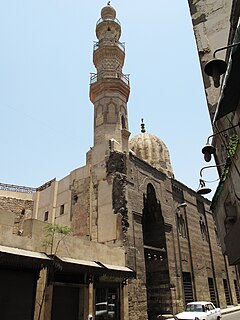 W
WThe Mosque and Khanqah of Shaykhu is an Islamic complex in Cairo built by the Grand Emir Sayf al-Din Shaykhu al-Nasiri. The mosque was built in 1349, while the khanqah was built in 1355. Shaykhu was the Grand Emir under the rule of Sultan an-Nasir Hasan.
 W
WThe Mosque of Ibn Tulun is located in Cairo, Egypt. It is the oldest mosque in Egypt as well as the whole of Africa surviving in its full original form, and is the largest mosque in Cairo in terms of land area. Since Ibn Tulun Mosque has much open space, it boasts both sunlight and shadows. It is built around an open square courtyard which allows natural light to travel through. Ibn Tulun Mosque features Samarra style - its decorations being created from carved stucco and wood. This mosque is a popular tourist attraction.
 W
WThe Great Mosque of Muhammad Ali Pasha or Alabaster Mosque is a mosque situated in the Citadel of Cairo in Egypt and was commissioned by Muhammad Ali Pasha between 1830 and 1848.
 W
WThe Mosque of Qani-Bay is a mosque in Cairo, Egypt. The complex is named after Qani-Bay al-Sayfi, nicknamed "al-Rammah", who was Grand Master of the Horse during the reign of Sultan al-Ghuri. It was built between AD 1503 and 1504 on a hill watching over the hippodrome and Mosque-Madrassa of Sultan Hassan. The site was chosen since the horse market and stables of the Citadel were originally located just off the square.
 W
WMosque of Qanibay al-Muhammadi is one of the historical mosques in Cairo, Egypt, built in 1413 CE during the Burji dynasty era of Mamluk Sultanate. It is located at Al-Saleeba street in Islamic Cairo, and there is Mosque and Khanqah of Shaykhu at its neighbor.
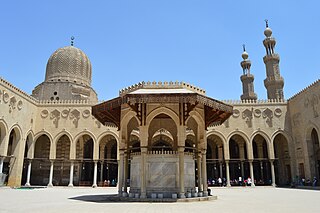 W
WThe Mosque of Sultan al-Mu'ayyad is a Mosque in Cairo, Egypt next to Bab Zuwayla built under the rule of sultan Al-Mu'ayyad Sayf ad-Din Shaykh from whom it takes its name, "Al-Mu'ayyad", meaning The Supporter in Arabic language. Construction began in 1415 and the mosque was completed in 1421. The complex included a Friday mosque and a madrasa for four madhhabs. It replaced a prison which originally stood next to Bab Zuwayla.
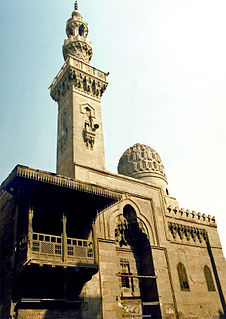 W
WThe Funerary Complex of Amir Taghribirdi or Mosque and Madrasa of Taghribirdi is a historical funerary complex of a mosque and madrasa located in Cairo, Egypt and built in the year 1440, during the Mamluk Sultanate. This monument honors Amir Taghribirdi, the mosque's commissioner and the secretary to Sultan al-Zahir Jaqmaq. The mosque and madrasa of Taghribirdi is located on a corner of Saliba street. This is not to be confused with a different Mosque of Taghribirdi, which is located in the Darb al-Maqasis neighborhood of Cairo.
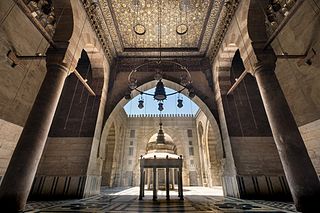 W
WMosque-Madrassa of Sultan Barquq or Mosque-Madrassa-Khanqah of Az-Zaher Barquq is a religious complex in Islamic Cairo, the historic medieval district of Cairo, Egypt. It was commissioned by Sultan al-Zahir Barquq as a school for religious education in the four Islamic schools of thought, composed of a mosque, madrassa, mausoleum and khanqah. The complex was constructed in 1384-1386 CE, with the dome added last. It was the first architectural facility built during the time of the Circassian (Burji) dynasty of Mamluk Sultanate.
 W
WThe Mosque-Madrassa of Sultan Hassan is a monumental mosque and madrassa located in the historic district of Cairo, Egypt. It was built between 1356 and 1363 during the Bahri Mamluk period, commissioned by Sultan an-Nasir Hasan. The mosque was considered remarkable for its massive size and innovative architectural components, and is still considered one of the most impressive historic monuments in Cairo today.
 W
WMosque-Sabil of Sulayman Agha al-Silahdar or Mosque-Sabil-Kuttab of Sulayman Agha al-Silahdar is a complex of mosque, sabil and kuttab established during the era of Muhammad Ali Pasha in Islamic Cairo, the historic medieval district of Cairo, Egypt. It is located at the beginning of Burjouan alley of the famed Muizz Street. On the other side it faces the extension of Al-Nahasin Street leading to the Bab Al-Shaareya square.
 W
WThe Mosque of Abu Dahab is a mosque in Cairo, Egypt just beside Al Azhar Mosque. The mosque was built by the Amir Mohamed Beh Abu El Dahab, one of the leaders of Egypt during the rule of the Ottoman Empire. It is located in Al Azhar Street, beside the main entrance of the Azhar Mosque and it is the fourth mosque in Egypt to be built according to the Ottoman style of architecture. It was originally built as a madrasa to host the number of students that were coming to study in the Azhar University.
 W
WThe Sultan al-Nasir Muhammad ibn Qalawun Mosque is an early 14th-century mosque at the Citadel in Cairo, Egypt. It was built by the Mamluk sultan Al-Nasr Muhammad in 1318 as the royal mosque of the Citadel, where the sultans of Cairo performed their Friday prayers. The mosque is located across the street from the courtyard access to the Mosque of Muhammad Ali. The Sultan also built a religious complex in the center of the city, next to the one by his father Qalawun.
 W
WThe Rabaa Al-Adawiya Mosque, also transliterated Rabi'a Al-Adawiya, Rabaa El-Adawia or Rabaa El-Adaweya, is a mosque located on the northern edge of Nasr City district in eastern Cairo. It was named after the 8th-century Sufi saint Rabia Al-Adawiya.
 W
WAl-Rifa'i Mosque is located in Midan al-Qal'a, adjacent to the Cairo Citadel. Now, it is also the royal mausoleum of Muhammad Ali's family. The building is located opposite the Mosque-Madrassa of Sultan Hassan, which dates from around 1361, and was architecturally conceived as a complement to the older structure. This was part of a vast campaign by the 19th century rulers of Egypt to both associate themselves with the perceived glory of earlier periods in Egypt's Islamic history and modernize the city. The mosque was constructed next to two large public squares and off of several European style boulevards constructed around the same time.
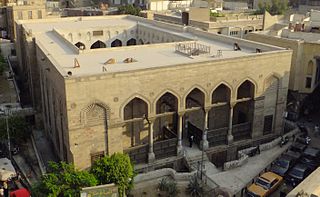 W
WThe Mosque of Al Salih Tala'i is a late Fatimid-era mosque built by the vizier Tala'i ibn Ruzzik in 1160. It is located south of Bab Zuweila, just outside the southern entrance to the old walled city of Cairo.
 W
WSayeda Aisha Mosque is a mosque in Cairo, Egypt which contains mausoleum for Sayyida Aisha, a daughter of Ja'far al-Sadiq and a sister of Musa al-Kadhim.
 W
WThe Sinan Pasha Mosque is a mosque in the Cairo district of Bulaq. It was established by the governor of Cairo Koca Sinan Pasha around 1571.
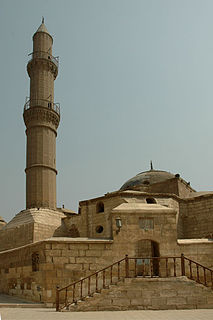 W
WSulayman Pasha al-Khadem Mosque, also known as Sariat al-Jabal Mosque, is a historical mosque established in 1528 by Suleiman Pasha Al-Khadem, one of the Ottoman rulers of Egypt. It is located inside the Cairo Citadel at the top of Mount Mokattam, and originally erected for the use of the jannisaries stationed in the northern enclosure. It is the first mosque established in Egypt in Ottoman architectural style.
 W
WThe Sultan Al-Ghuri Complex or Funerary complex of Sultan al-Ghuri, also known as al-Ghuriya, is a monumental Islamic religious and funerary complex built by Sultan Qansuh al-Ghuri between 1503 and 1505 CE. The complex consists of two major buildings facing each other on al-Mu'izz li-Din Allah street, in the Fahhamin Quarter, in the middle of the historic part of Cairo, Egypt. The eastern side of the complex includes the Sultan's mausoleum, a khanqah, a sabil, and a kuttab, while the western side of the complex is a mosque and madrasa. Today the mosque-madrasa is still open as a mosque while the khanqah-mausoleum is open to visitors as a historic site.
 W
WThe Sultaniyya Mausoleum is a Mamluk-era funerary complex located in the Southern Cemetery of the Qarafa, the necropolis of Cairo, Egypt. It is believed to have been built in the 1350s and dedicated to the mother of Sultan Hassan. It is notable for its unique pair of stone domes.
 W
WThe Mosque of al-Zahir Baybars is a mosque built in Cairo, Egypt by the Mamluk Sultan al-Zahir Baybars al-Bunduqdari.